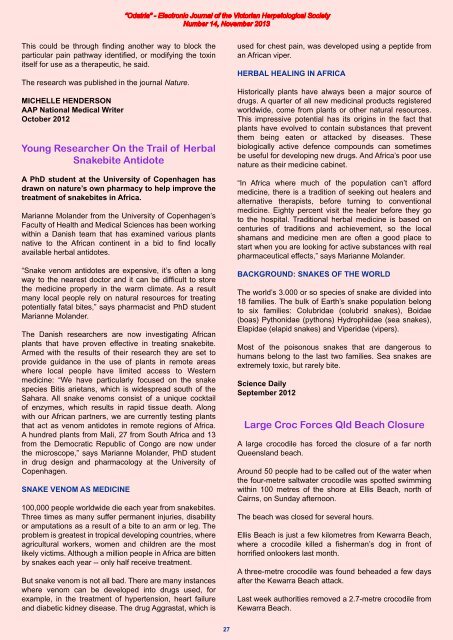Odatria_14_NOV13 - Victorian Herpetological Society
Odatria_14_NOV13 - Victorian Herpetological Society
Odatria_14_NOV13 - Victorian Herpetological Society
Create successful ePaper yourself
Turn your PDF publications into a flip-book with our unique Google optimized e-Paper software.
This could be through finding another way to block theparticular pain pathway identified, or modifying the toxinitself for use as a therapeutic, he said.The research was published in the journal Nature.MICHELLE HENDERSONAAP National Medical WriterOctober 2012Young Researcher On the Trail of HerbalSnakebite AntidoteA PhD student at the University of Copenhagen hasdrawn on nature’s own pharmacy to help improve thetreatment of snakebites in Africa.Marianne Molander from the University of Copenhagen’sFaculty of Health and Medical Sciences has been workingwithin a Danish team that has examined various plantsnative to the African continent in a bid to find locallyavailable herbal antidotes.“Snake venom antidotes are expensive, it’s often a longway to the nearest doctor and it can be difficult to storethe medicine properly in the warm climate. As a resultmany local people rely on natural resources for treatingpotentially fatal bites,” says pharmacist and PhD studentMarianne Molander.The Danish researchers are now investigating Africanplants that have proven effective in treating snakebite.Armed with the results of their research they are set toprovide guidance in the use of plants in remote areaswhere local people have limited access to Westernmedicine: “We have particularly focused on the snakespecies Bitis arietans, which is widespread south of theSahara. All snake venoms consist of a unique cocktailof enzymes, which results in rapid tissue death. Alongwith our African partners, we are currently testing plantsthat act as venom antidotes in remote regions of Africa.A hundred plants from Mali, 27 from South Africa and 13from the Democratic Republic of Congo are now underthe microscope,” says Marianne Molander, PhD studentin drug design and pharmacology at the University ofCopenhagen.SNAKE VENOM AS MEDICINE100,000 people worldwide die each year from snakebites.Three times as many suffer permanent injuries, disabilityor amputations as a result of a bite to an arm or leg. Theproblem is greatest in tropical developing countries, whereagricultural workers, women and children are the mostlikely victims. Although a million people in Africa are bittenby snakes each year -- only half receive treatment.But snake venom is not all bad. There are many instanceswhere venom can be developed into drugs used, forexample, in the treatment of hypertension, heart failureand diabetic kidney disease. The drug Aggrastat, which isused for chest pain, was developed using a peptide froman African viper.HERBAL HEALING IN AFRICAHistorically plants have always been a major source ofdrugs. A quarter of all new medicinal products registeredworldwide, come from plants or other natural resources.This impressive potential has its origins in the fact thatplants have evolved to contain substances that preventthem being eaten or attacked by diseases. Thesebiologically active defence compounds can sometimesbe useful for developing new drugs. And Africa’s poor usenature as their medicine cabinet.“In Africa where much of the population can’t affordmedicine, there is a tradition of seeking out healers andalternative therapists, before turning to conventionalmedicine. Eighty percent visit the healer before they goto the hospital. Traditional herbal medicine is based oncenturies of traditions and achievement, so the localshamans and medicine men are often a good place tostart when you are looking for active substances with realpharmaceutical effects,” says Marianne Molander.BACKGROUND: SNAKES OF THE WORLDThe world’s 3.000 or so species of snake are divided into18 families. The bulk of Earth’s snake population belongto six families: Colubridae (colubrid snakes), Boidae(boas) Pythonidae (pythons) Hydrophiidae (sea snakes),Elapidae (elapid snakes) and Viperidae (vipers).Most of the poisonous snakes that are dangerous tohumans belong to the last two families. Sea snakes areextremely toxic, but rarely bite.Science DailySeptember 2012Large Croc Forces Qld Beach ClosureA large crocodile has forced the closure of a far northQueensland beach.Around 50 people had to be called out of the water whenthe four-metre saltwater crocodile was spotted swimmingwithin 100 metres of the shore at Ellis Beach, north ofCairns, on Sunday afternoon.The beach was closed for several hours.Ellis Beach is just a few kilometres from Kewarra Beach,where a crocodile killed a fisherman’s dog in front ofhorrified onlookers last month.A three-metre crocodile was found beheaded a few daysafter the Kewarra Beach attack.Last week authorities removed a 2.7-metre crocodile fromKewarra Beach.27


